Pavel's Last Day
Group picnic 2015
Fiber green
Corning
Supercontinuum
Group bowling
CLEO 2018 group dinner
Dispersed, visible supercontinuum
Group photo - Logan's last day
2024 Group dinner
Our Research
We are currently focused on nonlinear wave phenomena in optical fibers. In one project, we develop fiber lasers that generate ultrashort light pulses. In another, we investigate nonlinear wave propagation in multimode fibers. See below for our most recent publications.
Yi-Hao_gas-Raman-theory
Unified and vector theory of Raman scattering in gas-filled hollow-core fiber across temporal regimes
Raman scattering is an important physical phenomenon that enables wavelength conversion beyond what can be achieved with natural materials, nonlocal interactions between pulses for material examinations, and so on. However, it hasn't been well-studied. In particular, there is no a single theory that can cover various temporal regimes for ultrashort pulse applications. Here, we develop a theory to comprehensively study the Raman scattering, which also make connections of several physical phenomena across different regimes that were used to be treated as different phenomena. This theory constitutes a fundamental yet crucial cornerstone of Raman theory.
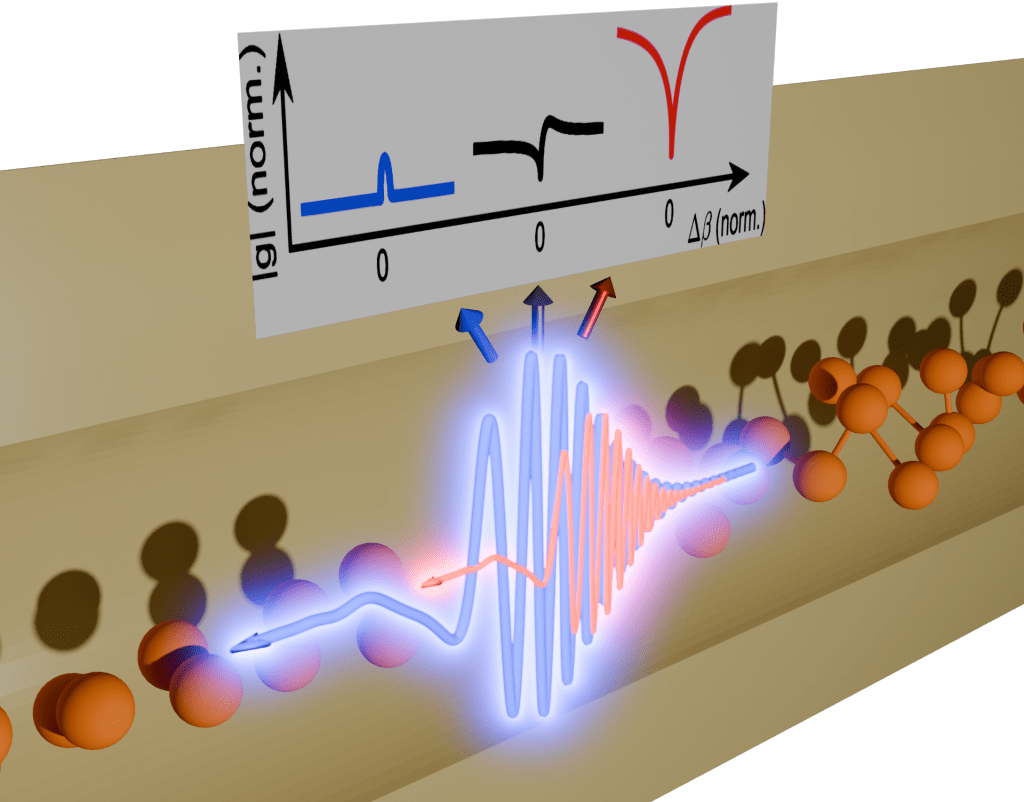
Henry’s fiber Regen
Single-mode regenerative amplification in multimode fiber
The peak power performance of ultrafast fiber lasers scales with fiber mode area, but large fibers host multiple modes that are difficult to control. We demonstrate a technique for single-mode operation of highly multimode fiber based on regenerative amplification. This results in a short-pulse fiber source with, to our knowledge, an unprecedented combination of features: high gain (>55 dB) with negligible amplified spontaneous emission, high pulse energy (>50 µJ), good beam quality (𝑀2≤1.3), and transform-limited (300 fs) pulses from a single amplification stage. We discuss peak intensity scaling to much higher levels and other opportunities for short-pulse generation in regenerative fiber amplifiers.
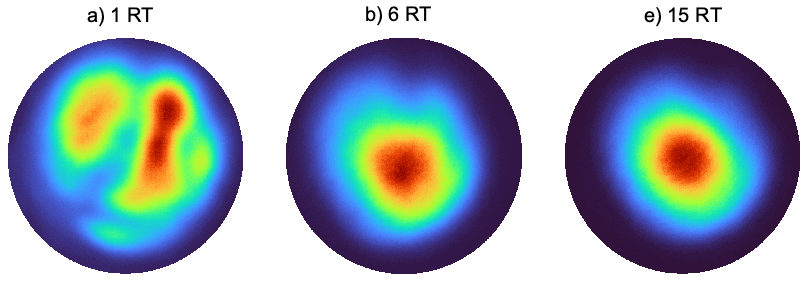
Nick_Optica2023
Spectral speckle customization
Speckle patterns are used in a broad range of applications including microscopy, imaging, and light–matter interactions. Tailoring speckles’ statistics can dramatically enhance their performance in applications. We present an experimental technique for customizing the spatio-spectral speckled intensity statistics of optical pulses at the output of a complex medium (a disordered multimode fiber) by controlling the spatial profile of the input light. We demonstrate that it is possible to create ensembles of independent speckle patterns with arbitrary statistics at a single wavelength, simultaneously at multiple decorrelated wavelengths, and even tailored statistics across an entire pulse spectrum.
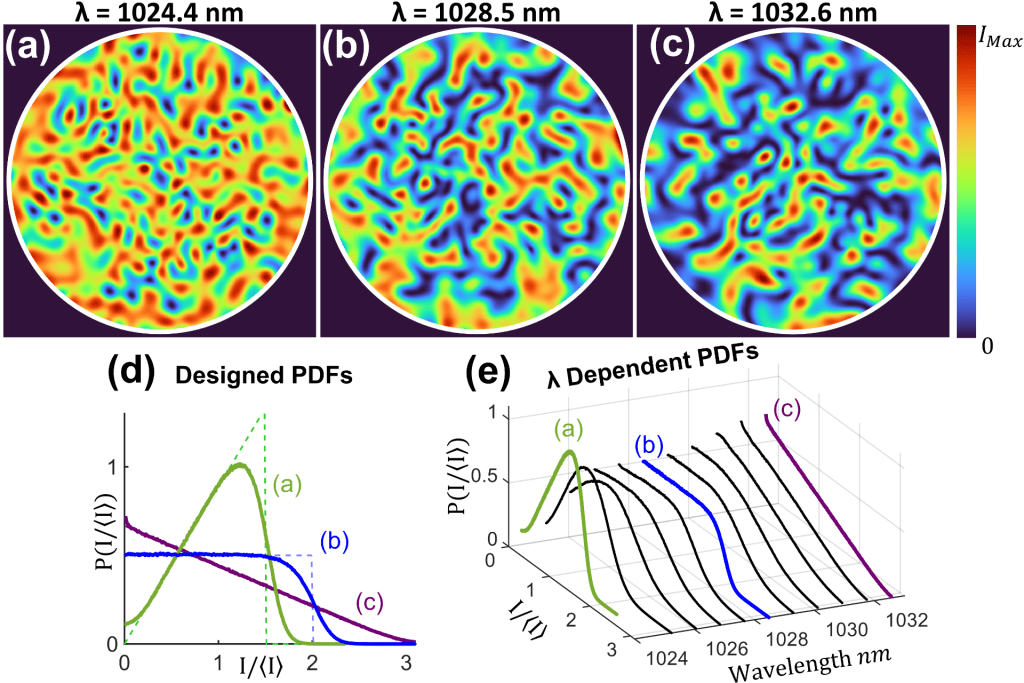
Yi-Hao_LWIR
Femtosecond long-wave-infrared generation in hydrogen-filled hollow-core fiber
This paper is chosen as Spotlight on Optics.
Generating femtosecond long-wave-infrared (LWIR) pulses is currently restricted to CO2 lasers and solid-state frequency converters, but waveguide-based Raman red shifting offers a promising alternative. In this study, we used a hydrogen-filled hollow-core fiber to generate LWIR pulses and found that a waveguide structure allows for tailored Raman gain. Using a two-pulse scheme with a two-color source, we achieved a numerical generation of clean 88-fs pulses at 12 μm with 41% total quantum efficiency. Our simulations also shed light on the nonlinear dynamics of the Raman gain, emphasizing the importance of a phonon amplifier for optimal performance.
In this work, especially its supplemental document, we have provided a complete introduction to the gas nonlinearity and its modeling detail. Please read it if you’re interested.
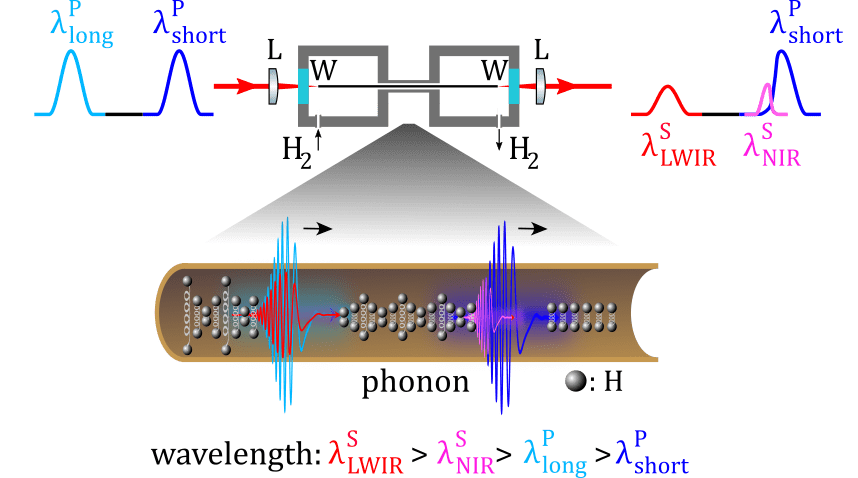
Yuhang Wu_AnomalousBC
Beam self-cleaning of femtosecond pulses in the anomalous dispersion regime
Kerr beam cleaning in graded-index multimode fiber has been investigated in experiments with sub-nanosecond pulses and in experiments with femtosecond pulses at wavelengths where the dispersion is normal. We report a theoretical and experimental study of this effect with femtosecond pulses and anomalous dispersion. In this regime, beam-cleaning is observed experimentally. Beyond the spatial dynamics, with the increase of input pulse energy, there is a strong temporal self-compression of the pulse from 500 fs down to around 30 fs (a factor of 17). Numerical simulations exhibit the qualitative trends of the experiments. Our study provides a way to enhance beam quality and temporal peak power at the same time in graded-index multimode fiber and the anomalous dispersion regime.
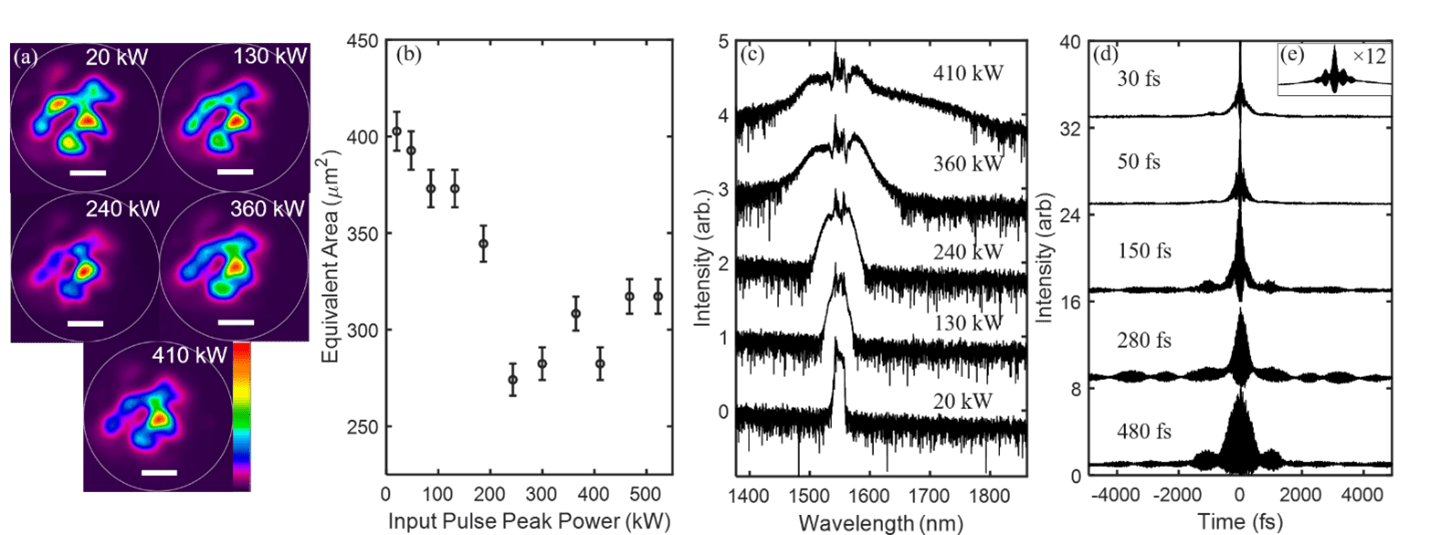
Yi-Hao_SSFS
Efficient soliton self-frequency shift in hydrogen-filled hollow-core fiber
SSFS has been considered as a good option for fiber sources with tunable wavelengths for a long time. Particularly, nonlinear microscopy, such as three-photon imaging, requires high peak power at 1300 and 1700 nm to overcome the depth limit of two-photon imaging. During the process, the Raman soliton gradually shifts towards the red color as it moves forward. Although several methods have been utilized to achieve these wavelengths, it seems challenging to increase the pulse energy in solid-glass fibers. Here, we have shown that SSFS can occur efficiently and cleanly in a hydrogen-filled anti-resonant hollow-core fiber. By using hydrogen and short input pulses, we have demonstrated continuous tuning of the wavelength between 1080 and 1600 nm. We have obtained pulse energies in the range of 20 to 110 nJ and durations below 50 fs over this spectral range.
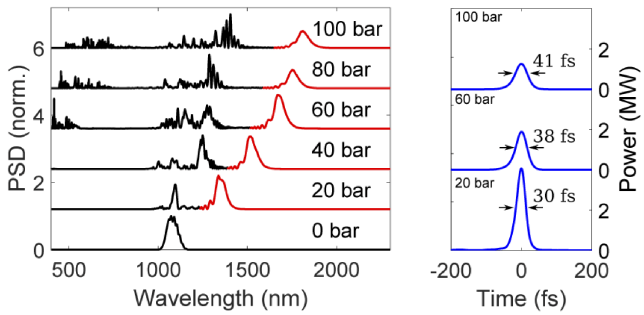
Henry_MMMamyshev
Multimode Mamyshev oscillator
Regular mode-locked lasers make short light pulses by synchronization or “locking” of many longitudinal cavity modes. It was recently shown that the transverse modes of a cavity can also be synchronized in a similar— but more general— form of mode-locking known as “spatiotemporal mode-locking” (STML). These lasers make ultrafast pulses that have spatial structure due to the many transverse modes involved. Understanding of this phenomenally complex phenomenon is limited: STML has so far been demonstrated a handful of times in relatively similar types of multimode fiber lasers. In this project, we study STML in a very different type of cavity architecture— the Mamyshev oscillator. The laser supports a vast array of mode-locked states. Learning to control these states in a meaningful way is a long-term goal which might enable gigawatt-class fiber lasers, or fiber lasers that generate purposefully-structured light for applications.
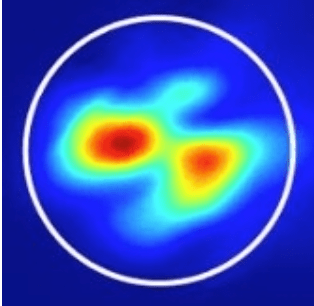
Henry_AllFiberMamyshev
Megawatt pulses from an all-fiber and self-starting femtosecond oscillator
Mamyshev Oscillators are a relatively new type of fiber laser with extraordinary pulse performance— these lasers generate the highest peak-power pulses from femtosecond fiber lasers by over a factor of 10. Mamyshev oscillators should be excellent tools for applications like microscopy and micromachining, but there’s a catch: most Mamyshev oscillators are impractical for applications outside laser labs since they need another mode-locked laser to start and are relatively complicated and expensive. In this project we designed a Mamyshev oscillator that solves these practical problems and comes in a totally fiber-integrated, ready-for-applications format. The laser generates pulses on par with those from much more complex Mamyshev oscillators, and remarkably starts with some simple electronics rather than an additional mode-locked laser. The pulse energy (80 nJ) and duration (40 fs) advances the state-of-the-art for all-fiber, self-starting lasers by 20x, and should be scalable by another factor of 5 with large-mode-area fiber.
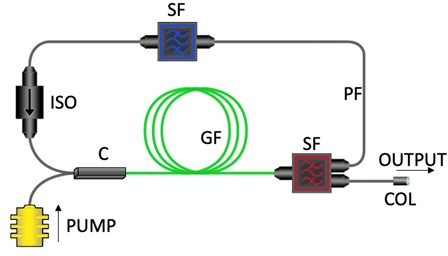
vOPCPA
Femtosecond optical parametric chirped-pulse amplification in birefringent step-index fiber
While optical fiber is convenient for many applications, generating short pulses outside of the typical gain bandwidth of rare-earth dopants commonly used in fiber amplifiers and oscillators is challenging. There are relatively few dopants that are compatible with the silica glass host, which leads to significant spectral gaps in which it is difficult to generate strong ultrashort pulses. It is sometimes possible to use nonlinear wavelength conversion to generate pulses in these spectral gaps, however. Parametric amplification conveniently generates two sidebands simultaneously, though to this point compressed pulse durations have been limited to ~200 fs and non-standard fiber waveguide geometries have been necessarily employed in order to achieve phase-matching. In this work, we demonstrate optical parametric chirped-pulse amplification in commercially available birefringent step-index optical fiber, delivering tens-of-nanojoule pulses compressible to 60-70 fs at 900 nm and 1270 nm. The key advances in this work were using birefringence rather than dispersion engineering in order to achieve phase-matching, and furthermore realizing that pumping the system with an extremely broadband pulse (from a gain-managed nonlinear amplifier) would allow the generation of energetic pulses compressible to very short duration. In addition, as the amplifier works with chirped pulses, we believe that the pulse energy may further be increased by chirping the pulses to longer duration and/or by employing large-mode area fiber for parametric amplification. We plan to use this system for hyperspectral degenerate and non-degenerate two-photon excitation fluorescence microscopy in the near future, enabling studies of complex biological processes in vivo.
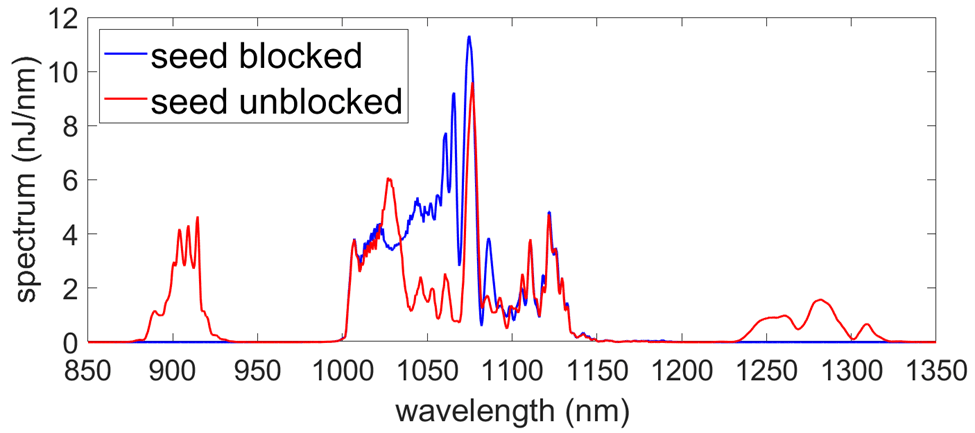
Starting Dynamics of Linear Mamyshev Oscillator
Starting dynamics of a linear-cavity femtosecond Mamyshev oscillator
This paper is chosen as Spotlight on Optics.
Mamyshev oscillator is a laser that not only generates strong pulses but is also capable of maintaining environmental stability. However, starting becomes a challenge due to the suppression of noise from continuous-wave (CW) lasing. Solutions to starting are to start with an external seed pulse, overlapped filter passbands to allow CW lasing, or self-seeding with a NPE starting arm described by Pavel et al. Here we proposed another solution to starting with pump modulation. It requires no mechanical flipping such as self-seeding and is demonstrated with full electronic control (Please watch the demonstration video here). Furthermore, it is demonstrated to reach a higher pulse energy by later increasing the filter separation. The laser is found to start reliably with pump modulation of a high repetition rate (>70 kHz) due to the emergence of a modulated mode-locked state. Besides, we found that damage from SBS constantly occurred in a linear cavity such that adding Faraday rotators is required.

Normal-dispersion fiber optical parametric chirped-pulse amplification
Normal-dispersion fiber optical parametric chirped-pulse amplification
An ongoing limitation of fiber lasers is their lack of broad wavelength tunability. Here, we address this problem using fiber optical parametric chirped-pulse amplification (FOPCPA), which combines the energy capacity of chirped pulse amplification with the spectral flexibility of optical parametric amplification and the practical benefits of fiber. Notably, this is the first FOPCPA to be pumped in the normally-dispersive regime, which permits phase-matching far from the pump wavelength.
The system operates by coupling a stretched, broadband pump pulse and a continuous-wave signal into a photonic crystal fiber. At each point in time, the monochromatic signal interacts via four-wave-mixing with a different wavelength of the chirped pump, resulting in an idler that is chirped in exactly the same manner as the pump. Scalability follows from the timescale-invariance of this process: stretching the pump at constant peak power likewise stretches the idler at constant peak power, increasing the energy without affecting the dechirped duration. By exploiting this property, we are able to convert pulses from the Yb-band to the important bio-imaging window near 1300 nm, with energies of >100 nJ and femtosecond-scale durations.

Self-seeded, multi-megawatt, Mamyshev oscillator
Self-seeded, multi-megawatt, Mamyshev oscillator
As was shown by Liu et al., the pulses from a Mamyshev oscillator can be enhanced by increasing the spectral separation between the two bandpass filters. However, this comes at a cost: the same mechanism that strongly stabilizes the pulse against continuous-wave breakthrough also suppresses the weak electric field fluctuations that are needed to initiate pulse formation. Thus, a Mamyshev oscillator may be constructed that supports very high-energy pulses, but which can be mode-locked only with the aid of an external seed source. In this paper, we address this problem by showing how a simple auxiliary cavity--a "starting arm"--may be embedded into a Mamyshev oscillator, enabling the oscillator to seed itself at the flip of a mirror. A video of this process can be viewed here. We have furthermore scaled part of the cavity to fiber with a 10-micron core diameter. The result is a fiber oscillator with self-starting-like behavior that can deliver 190-nJ, 35-fs pulses without any external amplification, for an unprecedented peak power of 3 MW after dechirping.

Spatiotemporal mode-locking in multimode fiber lasers
Spatiotemporal mode-locking in multimode fiber lasers
Unlike a conventional single-mode, 'one-dimensional' laser, the frequencies of a multimode, multidimensional laser are ordinarily very complicated (figure below, top left, where different colors correspond to different spatial modes). However, we showed that, for a properly designed laser (bottom), the laser's frequencies would adjust automatically into an organized, synchronized pattern (figure top right), corresponding to the emission of a 3D, multimode laser pulse at regular intervals. Pulses from this laser might eventually allow very sophisticated light-matter interactions, especially with complex molecules (different modes of the laser may interact with different 'modes', specific transitions, of molecules or other matter). We have some moderately crazy ideas to realize PW or even EW (exawatt) lasers with this approach.
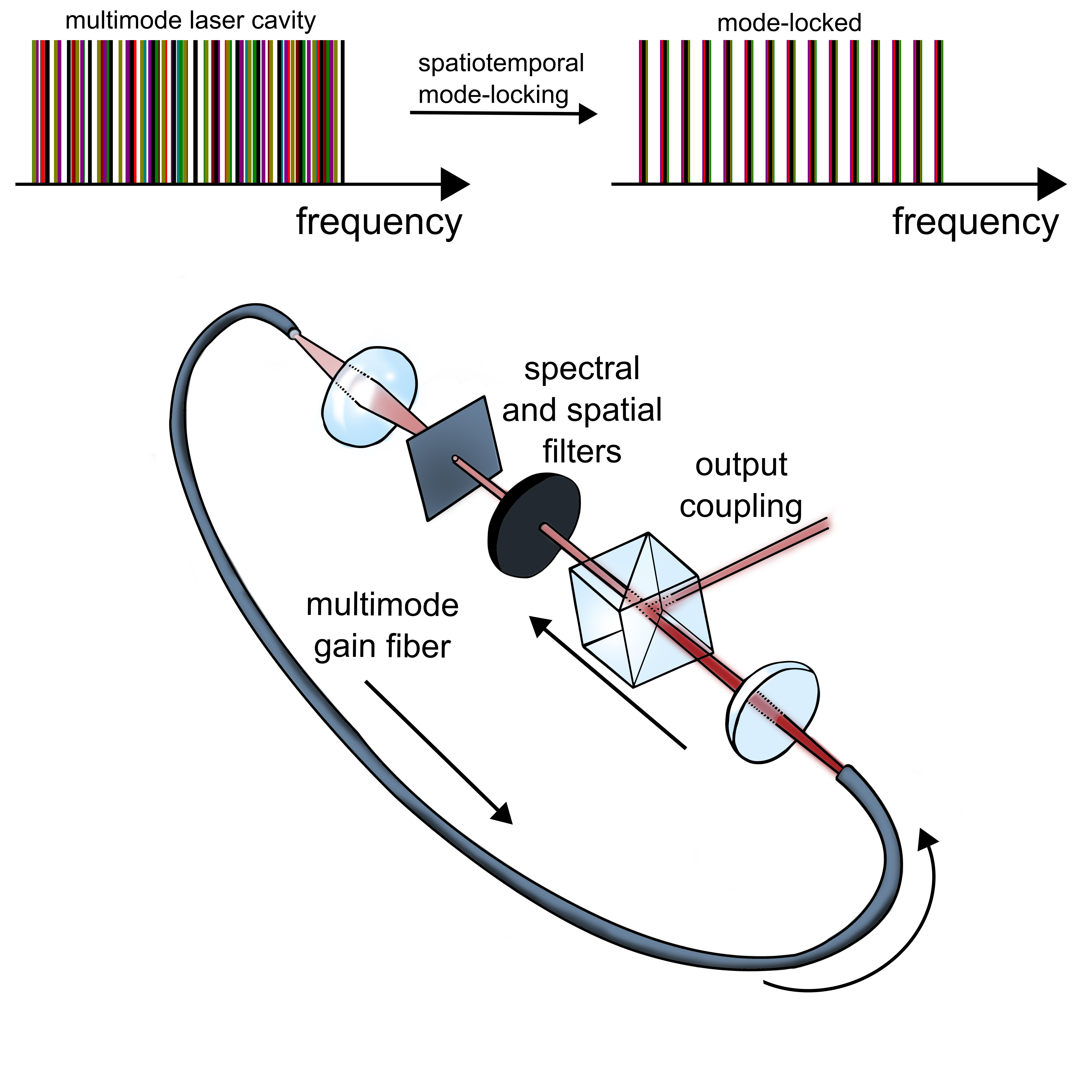
Megawatt peak power from a Mamyshev oscillator
Megawatt peak power from a Mamyshev oscillator
Historically, it has been really tough to make an ultrafast fiber laser that is both environmentally stable and that has good performance (i.e., it has similar performance as a Ti:sapphire oscillator). Recently, several groups have realized that a pair of spectral filters, each offset from the center of the laser gain spectrum, can be used as an effective saturable absorber. An intense pulse will experience nonlinear spectral broadening within fiber in between the filters, and can oscillate stably in a ring cavity formed in this way - a laser we call a 'Mamyshev oscillator' (see figure). Low-intensity pulses, or continuous-wave lasing, are meanwhile strongly attenuated. This mechanism, first proposed by Pavel Mamyshev for signal regeneration in telecommunications, is fully compatible with environmentally-stable laser designs. In this paper, we show that the Mamyshev oscillator can, when combined with the self-similar evolution of parabolic pulses, actually support extraordinary performance. Our initial experiments already show 10 times higher peak power than the previous state-of-the-art, and we are optimistic about further improvements.
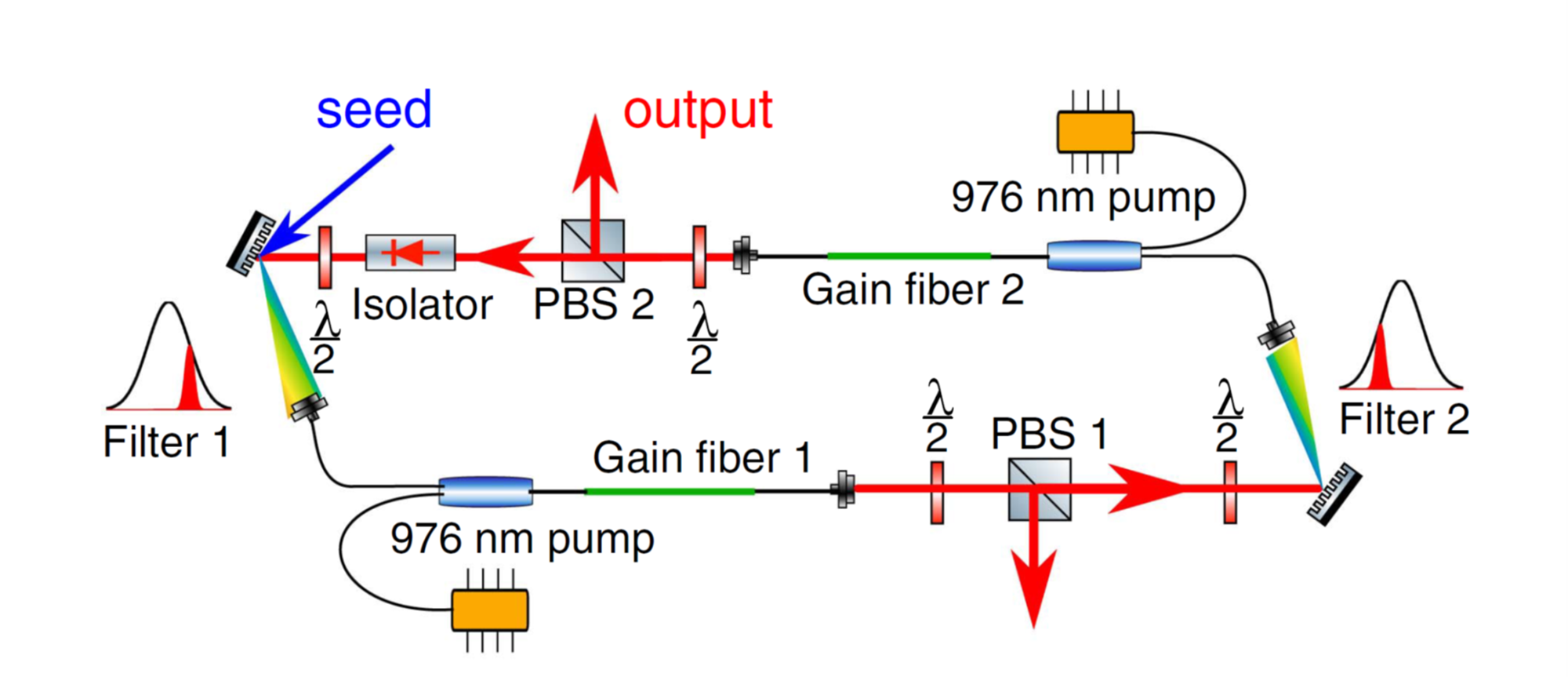
High-power femtosecond pulses without a modelocked laser
High-power femtosecond pulses without a modelocked laser
Modelocked lasers have long been a mainstay of ultrafast optics. However, they face ongoing challenges regarding long-term reliability, and can only emit pulses at regular intervals. Here, we present an alternative approach by seeding a fiber amplifier with a gain-switched diode. Gain-switched diodes emit pulses that are much longer and less coherent than those from modelocked oscillators. We address these issues using fiber nonlinearities: a Mamyshev regenerator isolates a coherent component of the pulse, and subsequent parabolic amplification allows the pulses to be compressed to 140 fs with 13 MW of peak power. Starting with a gain-switched diode means our system is highly robust and can in principle be electronically triggered in arbitrary pulse patterns. This flexibility may facilitate machining or microscopy sources (where pulses must be synchronized to scanning optics) or enable new types of functional neuroimaging (where specific neurons must be illuminated without saturating an entire sample).
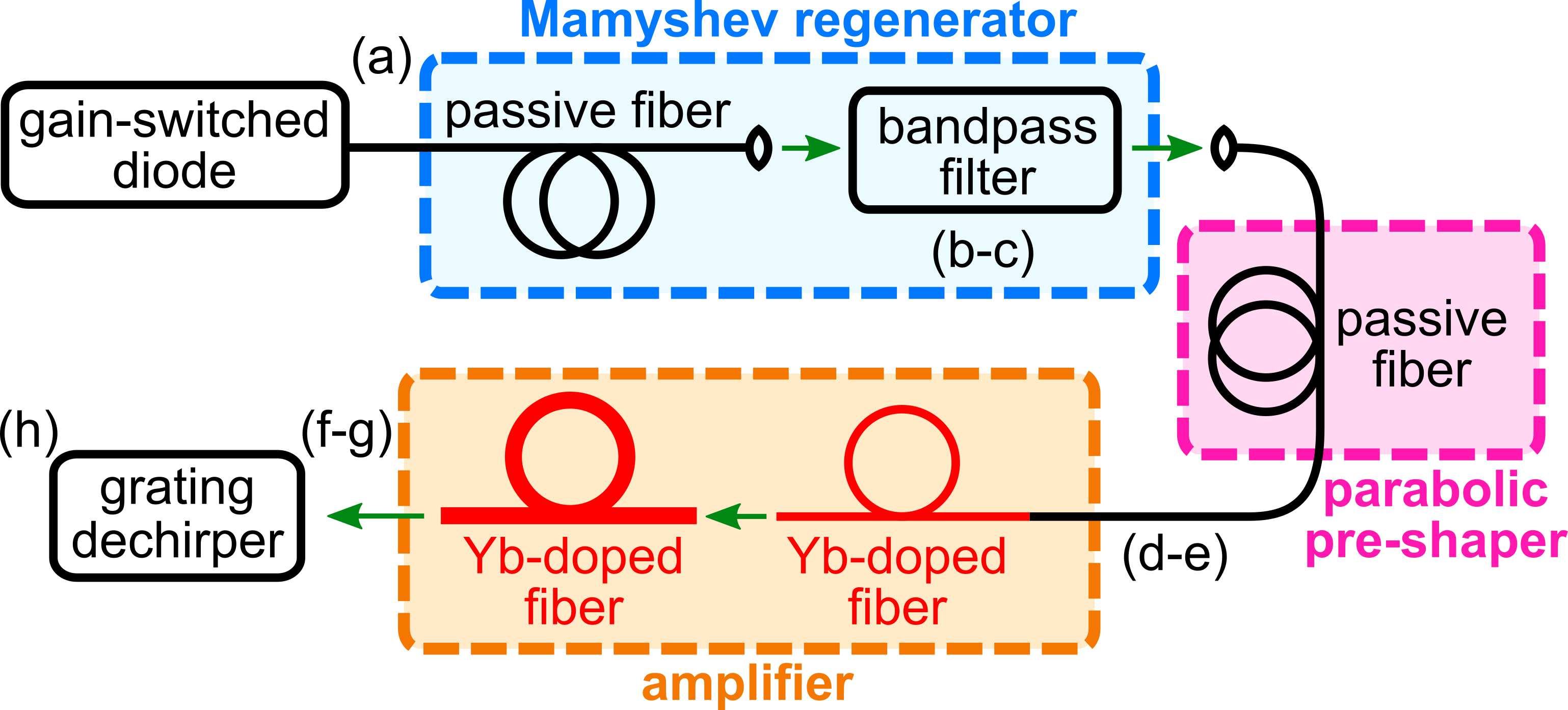
Self-similar pulse evolution in a fiber laser with a comb-like dispersion-decreasing fiber
Self-similar pulse evolution in a fiber laser with a comb-like dispersion-decreasing fiber
We demonstrate an erbium fiber laser with self-similar pulse evolution inside a comb-like dispersion-decreasing fiber (DDF), which has the potential of generating nJ-level few-cycle pulses directly from a fiber oscillator. A passive DDF is formally equivalent to a fiber with constant gain, and can thus support self-similar pulse evolution but without any bandwidth limitation. Considering the challenges to fabrication of DDF, we try to imitate an ideal DDF with a comb-like DDF based on segments of ordinary fibers, which offers major practical advantages. The laser generates 1.3 nJ pulses with parabolic shapes and linear chirps, which can be dechirped to 37 fs. This constitutes a 4-fold increase in pulse energy compared to previous reports of this pulse duration.
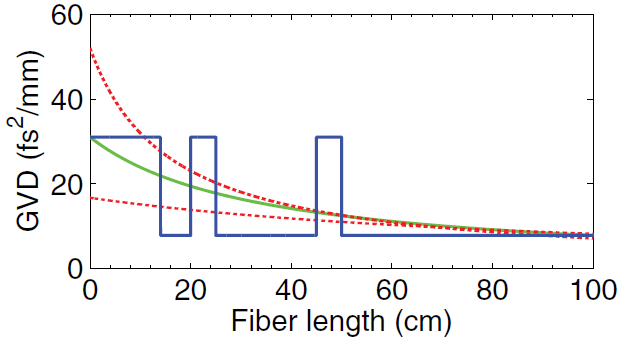
Generation of 8 nJ pulses from a normal-dispersion thulium fiber laser
Generation of 8 nJ pulses from a normal-dispersion thulium fiber laser
There is great interest in development of better short-pulse lasers in the 2-5 μm region. We show the first thulium-doped fiber laser at 2 μm to reap the performance benefits of pulse propagation at normal dispersion. Ultra-high numerical-aperture fibers provide normal dispersion and are employed to shift the cavity dispersion to the normal regime. A laser that exhibits elements of self-similar pulse evolution generates 8-nJ and 130-fs pulses, which corresponds to 4 times the highest peak power achieved previously by a Tm fiber laser.
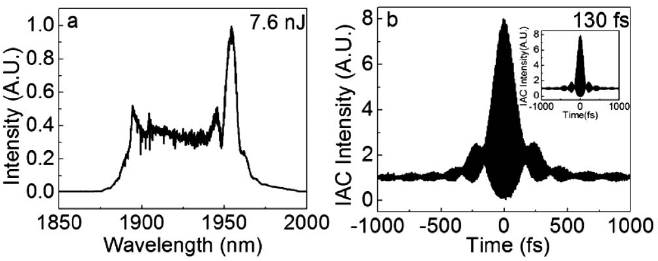
Spatiotemporal dynamics of multimode optical solitons
Spatiotemporal dynamics of multimode optical solitons
We launch pulses into multimode fiber, exciting multiple spatial modes. We show how nonlinear interactions between the modes give rise to a multimode soliton. A multimode soliton is a non-dispersing wavepacket that contains several distinct spatial mode components, and propagates through the fiber without changing its shape due to a balance between nonlinear and linear effects. We observe spatiotemporal soliton fission - the disintegration of an optical pulse into distinct multimode soliton components with different spatiotemporal properties. Lastly, we observe the effect of stimulated Raman scattering on multimode solitons. This causes them to shift to longer wavelengths, while maintaining their multimode soliton characteristics.
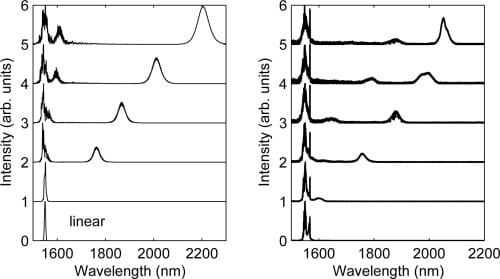
Ultrafast fiber lasers based on self-similar pulse evolution: a review of current progress
Ultrafast fiber lasers based on self-similar pulse evolution: a review of current progress
We summarize the state of research on lasers based on self-similar pulse evolutions, including passive similariton, amplifier similariton, and others. Self-similar fiber lasers are conceptually different from other kinds of short-pulse lasers. This distinction allows for exciting new laser design options.
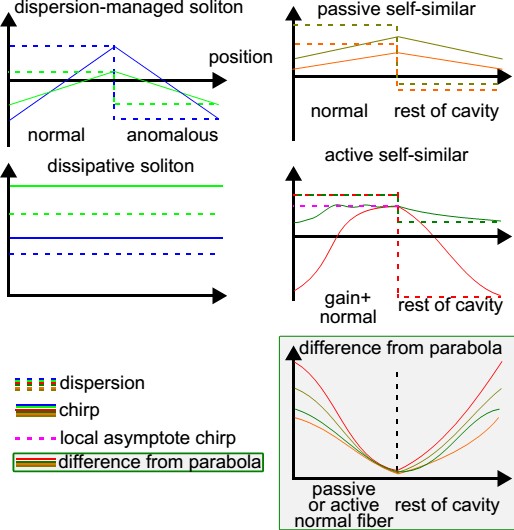
Ultrabroadband Dispersive Radiation by Spatiotemporal Oscillation of Multimode Waves
Ultrabroadband Dispersive Radiation by Spatiotemporal Oscillation of Multimode Waves
We show that intense pulses in multimode fiber oscillate in space and time, and that this creates resonant radiation across the electromagnetic spectrum. This work provides a route to tunable sources of ultrashort pulses from IR to ultraviolet and beyond. Dreaming, this work could lead to a fiber-format alternative to the free-electron laser.
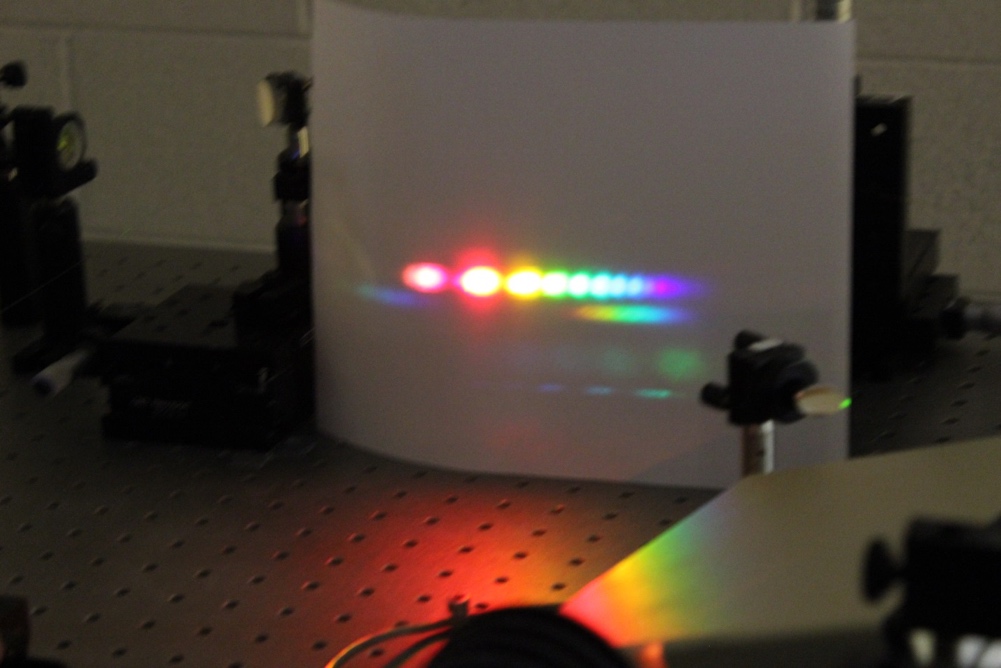
Opportunity news:
Postdoc hiring
by Yi-Hao Chen | Sep 13, 2023 | Must-show news
We’re looking for a postdoc working on Short-Pulse Fiber Lasers. Please see the Opportunities page for detail.
Honor news:
Yi-Hao’s gas-Raman paper on APP cover
by Yi-Hao Chen | Apr 3, 2024 | Honor news
Congratulations for Yi-Hao’s recent article “Unified and vector theory of Raman scattering in gas-filled hollow-core fiber across temporal regimes” being featured on the cover of APP‘s March 2024 issue.
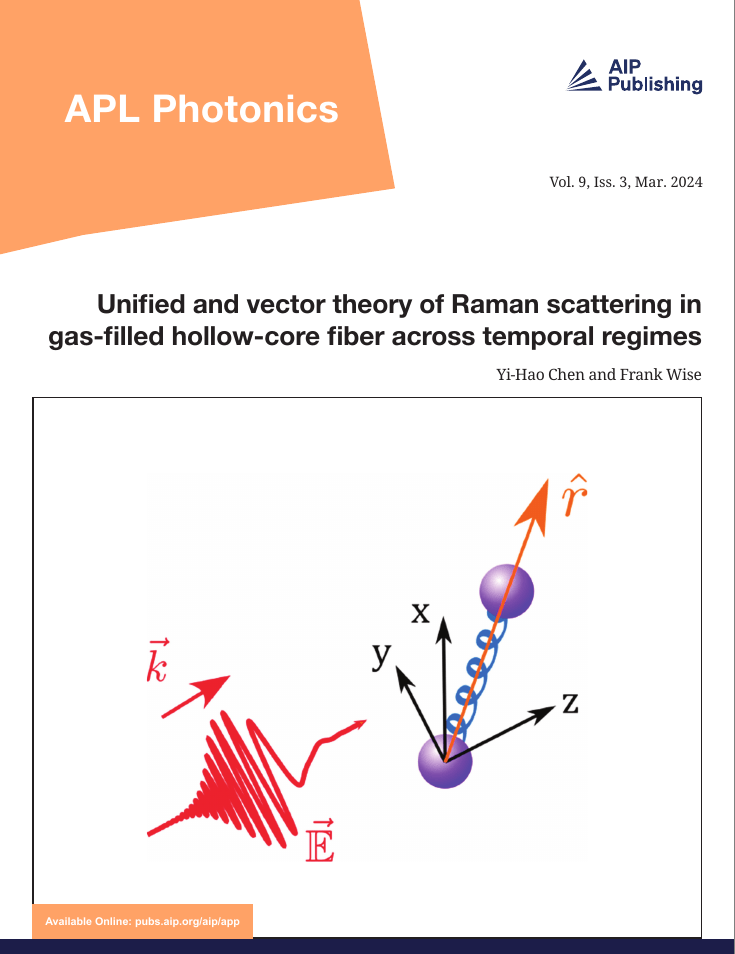
Multimode-soliton_on_APP_cover
by Yi-Hao Chen | Nov 7, 2023 | Honor news
Congratulations for Yuhang and Nick’s recent article “Highly multimode solitons in step-index optical fiber” being featured on the cover of APP‘s September 2023 issue.
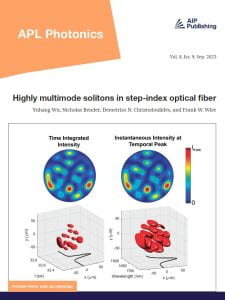
Yi-Hao Chen_JOSAB award
by Yuhang Wu | Mar 25, 2022 | Honor news
3/23/2022 – Congratulations to Yi-Hao Chen on being selected as the winner of the 2021 JOSA B Emerging Researcher Best Paper Prize!
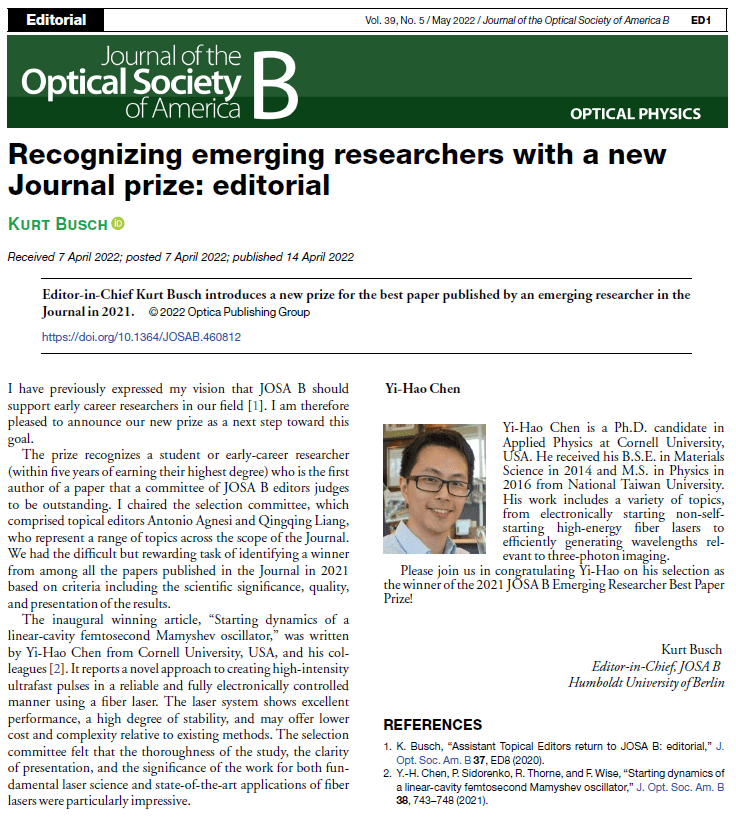
People news:
Auto Draft
by Yi-Hao Chen | May 25, 2025 | People's news
Congratulations to Dr. Yishai Eisenberg’s graduation.

Auto Draft
by Yi-Hao Chen | Feb 6, 2025 | People's news
Frank with Hanzhang Pei (M. Eng 2015) at Photonics West

Frank’s attending OSA spatiotemporal incubator (2024)
by Yi-Hao Chen | Nov 18, 2024 | People's news
Frank participated in the OSA Incubator on Spatiotemporal Structuring of Light.
